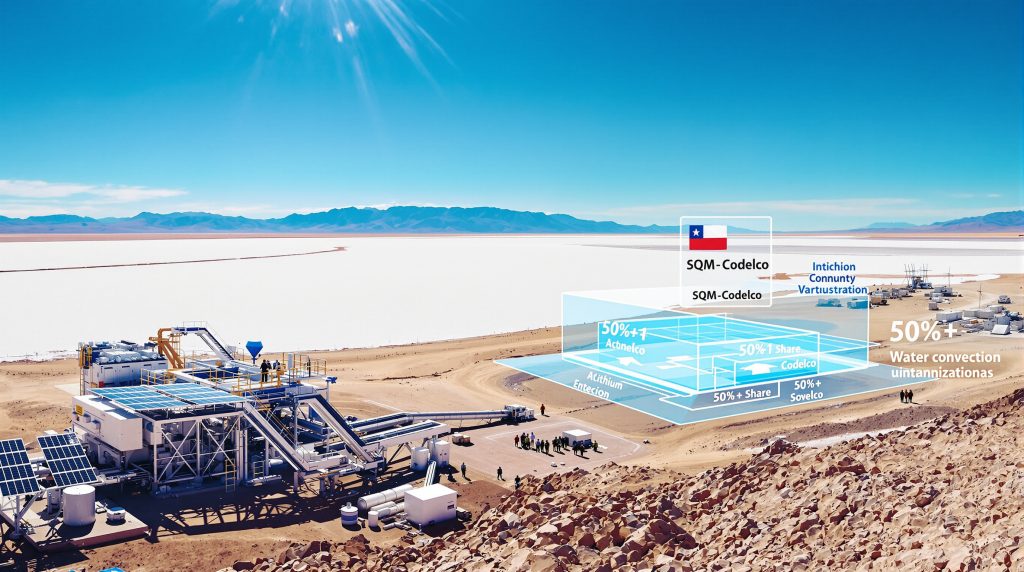How Does Chile's Lithium Contract System Work?
Chile's lithium governance framework centers on the Chilean Economic Development Agency (Corfo), which administers mining rights in the country's salt flats, particularly the world-renowned Atacama Salt Flat. Unlike traditional mining operations where the state extracts resources directly, Corfo implements a strategic leasing model, granting mining rights to private companies through specialized contracts with specific terms and conditions.
These contracts form the backbone of Chile's lithium governance structure, featuring royalty payments linked to market prices, environmental commitments, and development contributions that benefit both the national economy and local communities. This system allows Chile to maintain sovereignty over its valuable lithium resources while leveraging private sector expertise and capital.
The Role of Corfo in Chile's Lithium Industry
Corfo serves as the administrator and steward of lithium mining rights across Chile's salt flats. The agency doesn't engage in direct mining activities but instead functions as a regulatory body that oversees the leasing of lithium-rich territories to private companies. This approach allows Chile to maintain control over its strategic mineral resources while benefiting from private sector investment and technical capabilities.
The contractual framework established by Corfo dictates how lithium extraction proceeds, setting parameters for production volumes, environmental standards, and benefit-sharing mechanisms. Through these leasing arrangements, Corfo ensures that Chile's lithium wealth generates returns for national development while maintaining regulatory oversight of extraction activities.
Historical Development of Lithium Leasing Arrangements
Chile's approach to lithium governance has evolved significantly since the early 1980s when the government first designated lithium as a strategic resource of national importance. Initial contracts featured relatively modest royalty structures that failed to capture the resource's growing value in global markets.
Over the decades, Chile has progressively strengthened these agreements through strategic renegotiations. Each contract revision has aimed to increase state benefits, improve environmental protections, and enhance community participation in decision-making processes. This evolution reflects Chile's growing understanding of lithium's critical role in the global energy transition and its determination to maximize national benefits from this valuable resource.
What Changes Are Coming to Chile's Lithium Contracts?
In September 2025, Chile took a historic step in its lithium governance by finalizing new contractual frameworks that will reshape the sector for decades to come. These changes represent a profound shift in how Chile manages its lithium resources, balancing public and private interests while addressing environmental and social concerns.
The revised contracts reflect Chile's determination to capture greater value from its lithium resources while maintaining an investment environment that remains attractive to private partners. This delicate balancing act aims to secure Chile's position as a leading lithium producer while ensuring that benefits flow more equitably to the Chilean state and its citizens.
The New SQM-Codelco Partnership Framework
In a watershed development for Chile's lithium industry, Corfo submitted to the comptroller's office the final terms for a modified lease agreement with SQM through 2030 and a groundbreaking new 2031-2060 lease for a joint venture between SQM and state copper producer Codelco.
This partnership represents a fundamental shift in Chile's lithium strategy, marking the state's first significant direct participation in lithium production through Codelco, which will hold a controlling interest (50% plus one share) in the venture. By combining Codelco's status as a state enterprise with SQM's operational expertise, Chile aims to create a balanced partnership that serves both public and private interests.
The structure allows Chile to maintain production continuity while gradually increasing state involvement in the lithium sector. Industry analysts note this model could serve as a template for other resource-rich nations seeking to balance sovereign control with private sector efficiency.
Key Financial Terms in the Updated Contracts
The revised contracts feature an innovative royalty structure that links payments directly to global lithium prices rather than production volumes. This dynamic approach ensures that Chile captures more value during market upswings while providing companies with operational flexibility during price downturns.
Under the new financial framework, lithium producers will contribute a percentage of revenues that fluctuates based on prevailing market conditions. This system replaces older models that relied primarily on fixed royalty rates, which failed to adequately capture value during price surges.
The contracts also establish mechanisms for distributing lithium revenues to local governments and Indigenous communities, creating a more equitable benefit-sharing system. This approach acknowledges that resource development should generate tangible benefits for affected regions rather than concentrating wealth in the central government or private companies.
How Will These Contracts Benefit Local Communities?
The revised lithium contracts incorporate substantial provisions for community benefit-sharing, reflecting Chile's growing recognition that resource extraction must generate tangible advantages for affected populations. These mechanisms aim to transform lithium wealth into sustainable development opportunities for local communities.
By channeling a portion of lithium revenues directly to regional development initiatives, Chile seeks to address historical inequities in resource governance. This approach recognizes that communities bearing the environmental and social impacts of lithium production deserve a fair share of the benefits generated.
Indigenous Community Engagement and Monitoring
A groundbreaking feature of the new contracts is the establishment of a "monitoring table" led by Corfo that includes representatives from Indigenous communities affected by lithium operations. This mechanism will track compliance with commitments made by SQM and Codelco regarding environmental protection, water usage, and community development.
This participatory governance model represents a significant advancement in how Indigenous rights are respected in resource development. Rather than treating communities as passive stakeholders, the new system acknowledges their legitimate role in overseeing operations that affect their traditional territories.
The monitoring table will have access to operational data, environmental reports, and compliance information, enabling community representatives to verify that companies are fulfilling their contractual obligations. This transparency mechanism helps build trust between companies and communities while ensuring accountability.
Distribution of Benefits to Regional Development
The contracts stipulate that a portion of lithium revenues will be directed toward local governments and Indigenous communities in the Atacama region. These funds will support investment in infrastructure, education, healthcare, and sustainable development initiatives tailored to local priorities.
By channeling lithium wealth back to the regions where extraction occurs, Chile aims to create more balanced regional development. This approach helps ensure that resource-rich areas receive tangible benefits rather than merely bearing the environmental burdens of extraction activities.
The regional development funds will be governed by transparent allocation mechanisms with input from local stakeholders, ensuring that investments align with community priorities rather than being imposed from the central government. This participatory approach helps build local ownership and ensures that development initiatives address genuine community needs.
What Environmental Standards Are Included in the Contracts?
Environmental protection stands as a cornerstone of Chile's revised lithium contracts, reflecting growing awareness of the ecological sensitivity of the Atacama Desert ecosystem. The new agreements incorporate stringent environmental standards that address water usage, energy consumption, and ecosystem protection.
These enhanced environmental provisions aim to ensure that lithium production proceeds in a manner compatible with long-term ecosystem health and sustainability. By embedding robust environmental requirements in contractual frameworks, Chile seeks to prevent irreversible ecological damage while maintaining productive lithium operations.
Water Conservation Requirements
Water management represents a critical concern in the Atacama Desert, one of the driest regions on Earth where water resources are exceptionally precious. The new contracts include strict limits on brine extraction and freshwater usage, along with requirements for implementing water-efficient technologies throughout production processes.
Companies must regularly monitor and report their water consumption patterns, with penalties for exceeding established thresholds. This approach helps protect scarce water resources while incentivizing technological innovations that reduce water intensity in lithium production.
The contracts also require companies to develop comprehensive water management plans that consider cumulative impacts on regional hydrology. This systems-based approach acknowledges that individual operations must be evaluated within the broader context of regional water resources rather than in isolation.
Clean Energy Transition Mandates
The updated contracts require lithium producers to progressively increase their use of renewable energy in operations. Companies must develop and implement clean energy transition plans with specific targets and timelines for reducing fossil fuel dependency and carbon emissions.
This mandate aligns with Chile's broader climate goals while helping reduce the carbon footprint of lithium production. By requiring clean energy adoption, Chile ensures that its lithium—often marketed for its role in renewable energy systems—is produced with minimal climate impact.
The renewable energy requirements include regular progress reviews and compliance mechanisms, ensuring that companies make steady progress toward established targets rather than delaying implementation. This structured approach helps drive technological innovation while maintaining operational certainty for producers.
How Does Chile's Value-Added Strategy Work?
Chile's lithium strategy extends beyond extraction to encompass value addition within domestic borders. Rather than merely exporting raw lithium as a commodity, Chile seeks to develop sophisticated processing capabilities that capture more value from its mineral resources.
This value-added approach aims to transform Chile from a primary resource provider into a manufacturing hub for lithium-based products. By developing domestic processing capabilities, Chile hopes to create higher-paying jobs, strengthen technological capabilities, and diversify its economy beyond resource extraction.
Preferential Pricing Program for Domestic Manufacturing
A key mechanism in Chile's value-added strategy is its preferential pricing program that provides discounted lithium to companies establishing manufacturing operations within Chilean borders. Corfo will maintain this initiative under the new contracts, offering below-market prices for lithium used in domestic manufacturing of products such as cathode materials, battery-grade lithium refinery components, and other lithium-based goods.
This program aims to overcome the tendency for raw materials to be exported for processing elsewhere, which typically results in the highest-value activities occurring outside the resource-producing country. By incentivizing domestic manufacturing through preferential pricing, Chile hopes to develop a more sophisticated industrial ecosystem around its lithium resources.
The preferential pricing mechanism includes eligibility criteria that ensure beneficiaries establish genuine manufacturing operations with significant employment and technology transfer benefits for Chile. This approach helps prevent companies from exploiting the program without delivering meaningful development outcomes.
Challenges in Implementing Value-Added Initiatives
While Chile's value-added strategy is ambitious, previous attempts to establish domestic lithium processing industries have faced significant challenges. Global market volatility, technology gaps, and implementation difficulties have complicated efforts to move beyond resource extraction.
For example, earlier initiatives to attract battery manufacturers through preferential lithium quotas achieved mixed results, with some projects advancing while others failed to materialize. These experiences highlight the challenges of developing new industrial capabilities in globally competitive markets where established manufacturing centers enjoy significant advantages.
The revised contracts seek to address these challenges by providing greater certainty and more favorable terms for companies willing to invest in domestic processing. By offering longer contract periods and more substantial incentives, Chile hopes to overcome the obstacles that have hindered previous value-addition efforts.
What Regulatory Approvals Are Still Needed?
While Chile has finalized the contractual frameworks for its lithium strategy, several regulatory processes must be completed before full implementation. These approval processes reflect the international nature of the lithium market and the complex regulatory environment surrounding strategic resources.
The remaining regulatory steps primarily involve international approvals rather than domestic processes, highlighting the global interconnectedness of lithium supply chains. These processes underscore how national resource governance increasingly operates within international regulatory frameworks.
Chinese Antitrust Review Status
A significant remaining hurdle for the SQM-Codelco partnership is securing approval from Chinese antitrust regulators. While regulatory authorities in other jurisdictions have already approved the arrangement, the Chinese decision remains pending as of September 2025.
This final regulatory step reflects China's pivotal role in global lithium markets as both a major consumer and processor. Chinese authorities are evaluating the partnership's potential impacts on market competition and supply security, considering its implications for Chinese companies that rely on Chilean lithium inputs.
Industry analysts expect Chinese approval to be granted by the end of 2025, noting that the partnership's structure preserves production continuity while gradually increasing state participation. This balanced approach addresses concerns about supply disruptions that might otherwise trigger regulatory objections.
Timeline for Implementation
Once Chinese regulatory approval is secured, the partnership can be formally established, with transition processes beginning immediately. The modified contracts with SQM will govern operations until 2030, after which the new joint venture agreement between SQM and Codelco will take effect through 2060.
This phased implementation approach allows for operational continuity while gradually transitioning toward the new governance structure. The extended timeline provides certainty for all stakeholders, enabling long-term investment planning while allowing for adaptation to changing market conditions.
The implementation process includes specific milestones and transition mechanisms designed to ensure smooth operations throughout the changeover period. These provisions help maintain production stability while gradually integrating Codelco's oversight into existing operational frameworks.
What Are the Global Implications of Chile's Lithium Strategy?
Chile's revised approach to lithium governance carries significant implications for global markets and resource management practices. As one of the world's leading lithium producers, Chile's policies influence global supply dynamics, pricing trends, and governance approaches in other resource-rich nations.
The Chilean model represents an innovative attempt to balance multiple objectives: securing national benefits, attracting investment, protecting the environment, and respecting community rights. The success or failure of this approach will provide valuable lessons for countries worldwide grappling with similar resource governance challenges.
Impact on Global Lithium Markets and Pricing
Chile's approach to lithium governance, particularly the state's increased participation through Codelco, could influence global lithium markets in several ways. By potentially giving the Chilean state greater influence over production decisions, the new framework may affect global supply and pricing dynamics in this critical mineral market.
Industry analysts note that Chile's shift toward a more active state role coincides with similar trends in other lithium-producing regions, potentially signaling a broader shift in how countries approach strategic mineral governance. This trend toward greater state involvement could influence investment patterns and market expectations across the lithium sector.
The long-term nature of Chile's new contracts (extending to 2060) provides unprecedented certainty in a market often characterized by volatility and short-term planning horizons. This stability could enable more strategic investment decisions throughout the lithium value chain, potentially benefiting end-users in electric vehicle and energy storage markets.
Balancing National Interest and Investment Attraction
Chile's new lithium contracts attempt to balance capturing more value for the nation while maintaining an attractive investment environment. This balancing act is crucial as global competition for lithium investment intensifies, with numerous countries seeking to develop their resources and attract processing capabilities.
The hybrid model that combines state participation with private expertise represents an innovative approach to resource governance that may influence other nations' policies. By demonstrating that state involvement need not mean full nationalization, Chile offers a potential middle path for countries seeking greater benefits from their resources while maintaining private sector efficiency.
The success of Chile's approach will depend on effective implementation, market conditions, and the ability to maintain cooperative relationships between state and private partners. If successful, this model could reshape assumptions about resource governance and provide a template for other nations seeking to maximize benefits from critical minerals while ensuring sustainable development.
Chile's Lithium Strategy: Looking Ahead
Chile's revised lithium governance framework represents a significant evolution in how the country manages its valuable mineral resources. By increasing state participation through Codelco, strengthening environmental protections, enhancing community benefits, and promoting value-added activities, Chile is attempting to create a more sustainable and equitable lithium industry.
The implementation of these new contracts over the coming decades will test whether Chile can successfully balance competing priorities: maximizing national benefits, attracting investment, protecting sensitive ecosystems, respecting community rights, and developing domestic industries. The outcomes will provide valuable insights for mining industry evolution worldwide.
As global demand for lithium continues to grow, driven by electric vehicle adoption and renewable energy storage, Chile's role as a leading producer ensures that its governance approaches will significantly influence global markets. By pioneering innovative contractual frameworks that address multiple stakeholder interests, Chile may help establish new standards for responsible resource management in the clean energy transition.
Furthermore, Chile's approach to creating lithium industry tax breaks and incentives for companies implementing spodumene extraction insights demonstrates how government policy can shape industrial development. These incentives, coupled with requirements for mining decarbonisation benefits, create a comprehensive framework for sustainable resource development that balances economic, environmental, and social considerations.
Want to Know When the Next Major Mining Discovery Occurs?
Don't miss out on potentially transformative ASX mining discoveries as they happen. Discovery Alert's proprietary Discovery IQ model delivers real-time notifications on significant mineral discoveries, helping you identify actionable opportunities ahead of the broader market. Visit our discoveries page to explore how historic discoveries have generated substantial returns.




